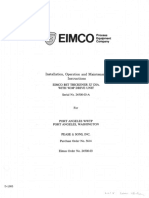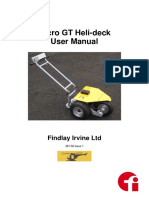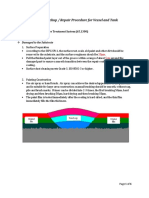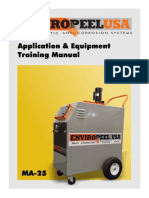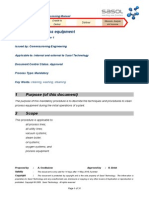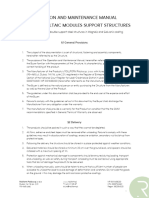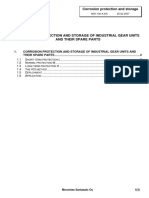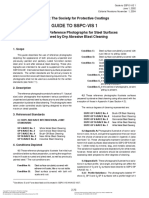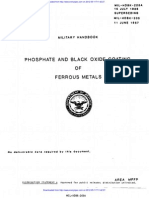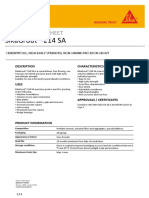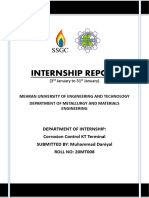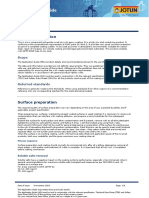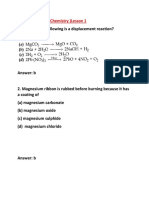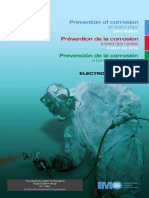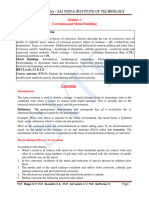Cut Your Costs by 75% - How A Little Prevention Can Save A Lot of Money
Cut Your Costs by 75% - How A Little Prevention Can Save A Lot of Money
Uploaded by
alexandrepimentaCopyright:
Available Formats
Cut Your Costs by 75% - How A Little Prevention Can Save A Lot of Money
Cut Your Costs by 75% - How A Little Prevention Can Save A Lot of Money
Uploaded by
alexandrepimentaOriginal Title
Copyright
Available Formats
Share this document
Did you find this document useful?
Is this content inappropriate?
Copyright:
Available Formats
Cut Your Costs by 75% - How A Little Prevention Can Save A Lot of Money
Cut Your Costs by 75% - How A Little Prevention Can Save A Lot of Money
Uploaded by
alexandrepimentaCopyright:
Available Formats
CUT YOUR COSTS BY 75% - HOW A LITTLE PREVENTION CAN SAVE A LOT OF MONEY
Allan Bruce
The Alocit Group, 112 Stirling Highway, NORTH FREMANTLE WA 615, Australia
Abstract: An introduction to cost benefits of the Enviropeel System, a system that uses a heating and
pumping system to melt and spray a thermoplastic material in order to provide a corrosion-inhibiting
protective coating around substrates of any size or shape. The material contains its own inhibitors, thus
providing both passive and active protection for protected surfaces. As part of the development process,
long-term testing of Enviropeel forms part of the DNV JIP Bolt Testing Programme, a programme which
includes Conoco-Phillips and BP, at whose behest the tests were planned. First results after 18 months of
the 10-year programme show very good results for Enviropeel. Case studies have shown from various
areas around the world with a focus on the experience of the Enviropeel System in WA with BHP Billiton
and Dampier Salt. Results over the past three to four years have been so spectacular, with projected
lifecycles of equipment increased by a factor of 5, that the Enviropeel system has become standard
practice due to the substantial cost savings.
Key Words: Alocit, bolts, bolted systems, cost effective, component life, corrosion-inhibiting, dipping, ,
encapsulating, environment, Enviropeel, loading, mining, offshore, polymer, pulley, recyclable,
renewability, re-usable, Robil, thermoplastic, samples, Slugger, flanges, valves, sprayable, Pilbara,
conveyor bearings, BHPBilliton, Dampier Salt
1 INTRODUCTION
The Enviropeel system uses a specially designed unit to spray apply a corrosion-inhibiting thermoplastic barrier coating. It
was developed to provide a solution for the many corrosion problems associated with bolted systems such as flanges and
valves, by adopting a whole system approach rather than providing a variety of individual solutions for the wide range of
problems that beset such systems.
When flanges or valves fail both safety and cost implications can be quite severe. At the most mundane level, replacement
will probably involve costly shut downs, cutting bolts and refurbishment. Leaks can affect the environment and the potential
for severe consequences is ever present. Bolted systems are vulnerable to corrosion in a number of ways. From galvanic
corrosion because they contain a variety of components, often of quite different materials – stainless steel flanges with carbon
steel bolts, for example. Gaps and voids bring pitting corrosion, assembly damages coatings and washers often fail.
WCEAM 2006 Paper 207 Page 1
Enviropeel isolates and encapsulates the substrate, depriving corrosion of the moisture it needs and bathing the entire
system in corrosion inhibitor, actively preventing rust and ingress of contamination.
2 THE STATUS QUO
What levels of protection are provided by current systems? In truth, not a lot. Of course, you can keep cleaning and
painting on a very regular basis but, at best, this locks all the bolt with accumulated paint and often leaves flanges streaming
with rust in as little as 6 months. Flange protectors, tape wraps, bolt caps – all can play a part but are either partial solutions or
so lock away the protected substrate that access is extremely difficult when required.
Pictured left is an example of what Although caps have been used to protect the bolts
can happen despite the best efforts - they are not protecting anywhere else - and they are
of engineers to provide protection. not even possible to use on all the bolts because in
some areas the heads are so close together access is
impossible. Caulking has been used to try and protect
the flange faces – but it has shrunk back, creating the
perfect environment for moisture to get in and
corrosion to accelerate!
And you have to feel sorry for the allen bolts at
the base – they have no chance. Streaming rust from
the structure above, galvanic corrosion from the
various metals in the system – and a perfect collection
point in the top of each bolt, apparently designed to
collect water and generate corrosion!
WCEAM 2006 Paper 207 Page 2
You might also like
- The Subtle Art of Not Giving a F*ck: A Counterintuitive Approach to Living a Good LifeFrom EverandThe Subtle Art of Not Giving a F*ck: A Counterintuitive Approach to Living a Good LifeRating: 4 out of 5 stars4/5 (5943)
- The Gifts of Imperfection: Let Go of Who You Think You're Supposed to Be and Embrace Who You AreFrom EverandThe Gifts of Imperfection: Let Go of Who You Think You're Supposed to Be and Embrace Who You AreRating: 4 out of 5 stars4/5 (1108)
- Never Split the Difference: Negotiating As If Your Life Depended On ItFrom EverandNever Split the Difference: Negotiating As If Your Life Depended On ItRating: 4.5 out of 5 stars4.5/5 (888)
- Hidden Figures: The American Dream and the Untold Story of the Black Women Mathematicians Who Helped Win the Space RaceFrom EverandHidden Figures: The American Dream and the Untold Story of the Black Women Mathematicians Who Helped Win the Space RaceRating: 4 out of 5 stars4/5 (926)
- Grit: The Power of Passion and PerseveranceFrom EverandGrit: The Power of Passion and PerseveranceRating: 4 out of 5 stars4/5 (598)
- Shoe Dog: A Memoir by the Creator of NikeFrom EverandShoe Dog: A Memoir by the Creator of NikeRating: 4.5 out of 5 stars4.5/5 (545)
- The Hard Thing About Hard Things: Building a Business When There Are No Easy AnswersFrom EverandThe Hard Thing About Hard Things: Building a Business When There Are No Easy AnswersRating: 4.5 out of 5 stars4.5/5 (354)
- Elon Musk: Tesla, SpaceX, and the Quest for a Fantastic FutureFrom EverandElon Musk: Tesla, SpaceX, and the Quest for a Fantastic FutureRating: 4.5 out of 5 stars4.5/5 (476)
- Her Body and Other Parties: StoriesFrom EverandHer Body and Other Parties: StoriesRating: 4 out of 5 stars4/5 (831)
- Service Manual - P ModelDocument731 pagesService Manual - P Modelerwin_teichmann100% (1)
- The Emperor of All Maladies: A Biography of CancerFrom EverandThe Emperor of All Maladies: A Biography of CancerRating: 4.5 out of 5 stars4.5/5 (274)
- The Little Book of Hygge: Danish Secrets to Happy LivingFrom EverandThe Little Book of Hygge: Danish Secrets to Happy LivingRating: 3.5 out of 5 stars3.5/5 (419)
- The World Is Flat 3.0: A Brief History of the Twenty-first CenturyFrom EverandThe World Is Flat 3.0: A Brief History of the Twenty-first CenturyRating: 3.5 out of 5 stars3.5/5 (2272)
- The Yellow House: A Memoir (2019 National Book Award Winner)From EverandThe Yellow House: A Memoir (2019 National Book Award Winner)Rating: 4 out of 5 stars4/5 (99)
- Devil in the Grove: Thurgood Marshall, the Groveland Boys, and the Dawn of a New AmericaFrom EverandDevil in the Grove: Thurgood Marshall, the Groveland Boys, and the Dawn of a New AmericaRating: 4.5 out of 5 stars4.5/5 (270)
- The Sympathizer: A Novel (Pulitzer Prize for Fiction)From EverandThe Sympathizer: A Novel (Pulitzer Prize for Fiction)Rating: 4.5 out of 5 stars4.5/5 (122)
- Team of Rivals: The Political Genius of Abraham LincolnFrom EverandTeam of Rivals: The Political Genius of Abraham LincolnRating: 4.5 out of 5 stars4.5/5 (235)
- A Heartbreaking Work Of Staggering Genius: A Memoir Based on a True StoryFrom EverandA Heartbreaking Work Of Staggering Genius: A Memoir Based on a True StoryRating: 3.5 out of 5 stars3.5/5 (232)
- On Fire: The (Burning) Case for a Green New DealFrom EverandOn Fire: The (Burning) Case for a Green New DealRating: 4 out of 5 stars4/5 (75)
- G1 Gravity Thickener EquipmentDocument136 pagesG1 Gravity Thickener EquipmentLUIS ALONSO TARAMUEL TAPIENo ratings yet
- Micro GT Heli-Deck User Manual: Findlay Irvine LTDDocument28 pagesMicro GT Heli-Deck User Manual: Findlay Irvine LTDalexandrepimentaNo ratings yet
- The Unwinding: An Inner History of the New AmericaFrom EverandThe Unwinding: An Inner History of the New AmericaRating: 4 out of 5 stars4/5 (45)
- Touch Up Painting Repair ProcedureDocument28 pagesTouch Up Painting Repair ProcedureSuman Ghosh67% (3)
- Manufacturing Process of Tower PartsDocument29 pagesManufacturing Process of Tower PartssAuRaBhNo ratings yet
- Training Manual Plus Cover Rev TD01 Zone 2Document43 pagesTraining Manual Plus Cover Rev TD01 Zone 2alexandrepimentaNo ratings yet
- An Introduction To The Enviropeel System: Presented byDocument42 pagesAn Introduction To The Enviropeel System: Presented byalexandrepimentaNo ratings yet
- Enviropeel: Application & Equipment Training ManualDocument24 pagesEnviropeel: Application & Equipment Training ManualalexandrepimentaNo ratings yet
- Understanding Enviropeel: Benefits of UseDocument2 pagesUnderstanding Enviropeel: Benefits of UsealexandrepimentaNo ratings yet
- Helideck Data SheetDocument2 pagesHelideck Data SheetalexandrepimentaNo ratings yet
- Product Data Sheet: 1145 Steel RenewDocument2 pagesProduct Data Sheet: 1145 Steel RenewMichael Torres TorresNo ratings yet
- Repairing ConcreteDocument19 pagesRepairing ConcreteMKOZERDEMNo ratings yet
- QMS360P Vol 4.5 Rev 1 Cleaning of Process EquipmentDocument31 pagesQMS360P Vol 4.5 Rev 1 Cleaning of Process Equipmentdupe2010No ratings yet
- ITW Rust Inhibitive Primer 7CZ Product Data 1469103Document2 pagesITW Rust Inhibitive Primer 7CZ Product Data 1469103rihtak123No ratings yet
- Standard Details For Roofing and SidingDocument56 pagesStandard Details For Roofing and SidingMario M. NavallascaNo ratings yet
- DTR Eng RollformDocument3 pagesDTR Eng RollformMichał ŚwiątekNo ratings yet
- Chloride Induced Stress Corrosion Cracking (CISCC) in PipelinesDocument6 pagesChloride Induced Stress Corrosion Cracking (CISCC) in PipelinesMohamed AtefNo ratings yet
- Plegadora ÚltimaDocument47 pagesPlegadora ÚltimaJuan Ignacio RivasNo ratings yet
- Corrosion Protection and StorageDocument3 pagesCorrosion Protection and StorageRaphael LinoNo ratings yet
- Hinge Specification GuideDocument4 pagesHinge Specification GuideJoemarie MartinezNo ratings yet
- SSPC Vis 1Document4 pagesSSPC Vis 1Herman SandyNo ratings yet
- Military Handbook For Manganese Phosphate and Black OxideDocument81 pagesMilitary Handbook For Manganese Phosphate and Black Oxidekhamai9No ratings yet
- Sikagrout - 214 SaDocument3 pagesSikagrout - 214 SaYASHICA VAITTIANATHANNo ratings yet
- SSGC Internship Report (REVISEDDocument13 pagesSSGC Internship Report (REVISEDYusra KhanNo ratings yet
- Gce Chemistry ReviewDocument41 pagesGce Chemistry Review7a4374 hisNo ratings yet
- Durability of Reinforced Concrete Structures - Theory Vs PracticeDocument20 pagesDurability of Reinforced Concrete Structures - Theory Vs PracticeCivilEngClub100% (2)
- Power Pro 6000 Instruction Manual Rev 3-11Document13 pagesPower Pro 6000 Instruction Manual Rev 3-11soilweaverNo ratings yet
- Barrier 77 PDFDocument8 pagesBarrier 77 PDFRizki AhmadNo ratings yet
- Year 7 MetalsDocument7 pagesYear 7 MetalsMissparish8No ratings yet
- Chemistry Form FiveDocument23 pagesChemistry Form FiveNorazlin Ujang100% (2)
- Chem Class 10 Term 1 MCQ S & ARDocument78 pagesChem Class 10 Term 1 MCQ S & ARINDHRA VARMANo ratings yet
- CatalogDocument56 pagesCatalogTaco ChiwawaNo ratings yet
- Specialty Products and Multi-Purpose GreasesDocument16 pagesSpecialty Products and Multi-Purpose GreasesИрк ИркNo ratings yet
- Prevention of Corrission On Board - 2010 PDFDocument249 pagesPrevention of Corrission On Board - 2010 PDFAnonymous XtvvG80zuNo ratings yet
- SEA Priming and Painting Slip Critical Steel Connections 120510Document24 pagesSEA Priming and Painting Slip Critical Steel Connections 120510muathNo ratings yet
- Module 2Document11 pagesModule 2shashistudy2125No ratings yet







































